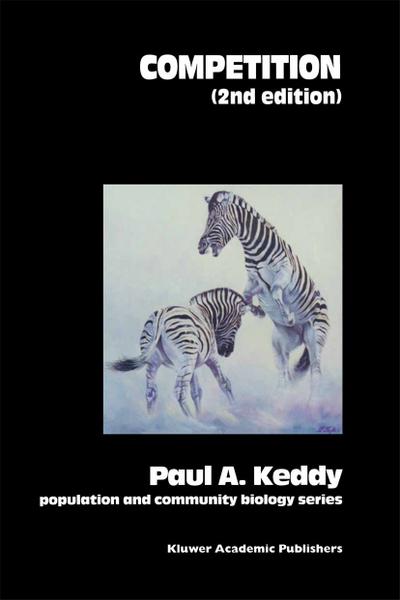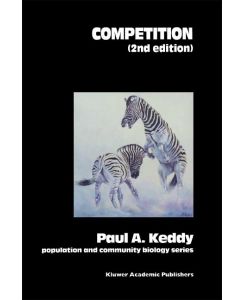
ISBN: 9780792360643
[ED: Buch], [PU: Springer Netherlands], Neuware - Competition is one of the most important factors controlling the distribution and abundance of living creatures. Sperm cells racing up re… Mehr…
| booklooker.de |

2001, ISBN: 0792360648
[EAN: 9780792360643], Neubuch, [SC: 0.0], [PU: Springer Netherlands], BIOLOGICAL; ECOLOGY; ENZYMES; FUNGI; SOIL, Druck auf Anfrage Neuware - Printed after ordering - Competition is one of… Mehr…
| ZVAB.com AHA-BUCH GmbH, Einbeck, Germany [51283250] [Rating: 5 (von 5)] NEW BOOK. Versandkosten:Versandkostenfrei. (EUR 0.00) Details... |

ISBN: 9780792360643
[ED: Buch], [PU: Springer Netherlands], Neuware - Competition is one of the most important factors controlling the distribution and abundance of living creatures. Sperm cells racing up re… Mehr…
| booklooker.de BuchWeltWeit Inh. Ludwig Meier e.K. Versandkosten:Versandkostenfrei, Versand nach Deutschland. (EUR 0.00) Details... |

2001, ISBN: 9780792360643
Gebunden, 576 Seiten, 241mm x 160mm x 37mm, Sprache(n): eng Competition is one of the most important factors controlling the distribution and abundance of living creatures. Sperm cells ra… Mehr…
| buchfreund.de MARZIES Buch- und Medienhandel, 14621 Schönwalde-Glien Versandkosten:Versandkostenfrei innerhalb der BRD. (EUR 0.00) Details... |

2001, ISBN: 0792360648
2nd ed. 2001 Gebundene Ausgabe biological; ecology; enzymes; Fungi; soil, mit Schutzumschlag 11, [PU:Springer Netherlands; Springer Netherland]
| Achtung-Buecher.de MARZIES.de Buch- und Medienhandel, 14621 Schönwalde-Glien Versandkosten:Versandkostenfrei innerhalb der BRD. (EUR 0.00) Details... |


ISBN: 9780792360643
[ED: Buch], [PU: Springer Netherlands], Neuware - Competition is one of the most important factors controlling the distribution and abundance of living creatures. Sperm cells racing up re… Mehr…

2001, ISBN: 0792360648
[EAN: 9780792360643], Neubuch, [SC: 0.0], [PU: Springer Netherlands], BIOLOGICAL; ECOLOGY; ENZYMES; FUNGI; SOIL, Druck auf Anfrage Neuware - Printed after ordering - Competition is one of… Mehr…

ISBN: 9780792360643
[ED: Buch], [PU: Springer Netherlands], Neuware - Competition is one of the most important factors controlling the distribution and abundance of living creatures. Sperm cells racing up re… Mehr…

2001, ISBN: 9780792360643
Gebunden, 576 Seiten, 241mm x 160mm x 37mm, Sprache(n): eng Competition is one of the most important factors controlling the distribution and abundance of living creatures. Sperm cells ra… Mehr…
2001, ISBN: 0792360648
2nd ed. 2001 Gebundene Ausgabe biological; ecology; enzymes; Fungi; soil, mit Schutzumschlag 11, [PU:Springer Netherlands; Springer Netherland]
Bibliographische Daten des bestpassenden Buches
| Autor: | |
| Titel: | |
| ISBN-Nummer: |
Detailangaben zum Buch - Competition
EAN (ISBN-13): 9780792360643
ISBN (ISBN-10): 0792360648
Gebundene Ausgabe
Taschenbuch
Erscheinungsjahr: 2001
Herausgeber: Springer
576 Seiten
Gewicht: 1,017 kg
Sprache: eng/Englisch
Buch in der Datenbank seit 2007-11-06T16:02:37+01:00 (Berlin)
Detailseite zuletzt geändert am 2024-04-22T17:03:45+02:00 (Berlin)
ISBN/EAN: 0792360648
ISBN - alternative Schreibweisen:
0-7923-6064-8, 978-0-7923-6064-3
Alternative Schreibweisen und verwandte Suchbegriffe:
Autor des Buches: keddy
Titel des Buches: competition
Daten vom Verlag:
Autor/in: P.A. Keddy
Titel: Population and Community Biology Series; Competition
Verlag: Springer; Springer Netherland
552 Seiten
Erscheinungsjahr: 2001-02-28
Dordrecht; NL
Sprache: Englisch
213,99 € (DE)
219,99 € (AT)
236,00 CHF (CH)
Available
XVII, 552 p. 45 illus.
BB; Hardcover, Softcover / Biologie; Evolution; Verstehen; biological; ecology; enzymes; fungi; soil; Evolutionary Biology; BC; EA
1 Studying Competition.- 1.1 The Importance of Competition.- 1.2 Stress, Strain and the Costs of Competition.- 1.3 Other Views on the Definition of Competition.- 1.4 Kinds of Competition.- 1.5 Historical Foundations: The First Competition Experiment.- 1.6 Competitive Dominance.- 1.7 Competition and the Organization of Living Systems.- 1.8 Competition and Human Societies.- 1.9 Conclusion.- 2 Resources.- 2.1 Kinds of Resources.- 2.2 Resources for Primary Producers.- 2.3 Resources for Consumers.- 2.4 Experimental Studies of Foraging for Resources in Patchy Environments.- 2.5 Effects of Chronic Scarcity of Resources.- 2.6 Resource Levels Change with Time.- 2.7 Humans and Resources.- 2.8 Conclusion.- 3 Competition in Action.- 3.1 Case Studies of Intraspecific Competition.- 3.2 Case Studies of Interspecific Competition.- 3.3 Literature Review of Case Studies.- 3.4 The Current Situation.- 4 Choosing the Tools.- 4.1 Descriptive, Comparative and Experimental Studies.- 4.2 Descriptive Studies.- 4.3 Comparative Studies.- 4.4 Experimental Studies.- 4.5 Choosing a Research Path.- 5 Competitive Hierarchies.- 5.1 Patterns in Community Matrices.- 5.2 Eight Examples of Communities with Competitive Hierarchies.- 5.3 On the Consistency of Hierarchies.- 5.4 Monocultures and Mechanisms.- 5.5 Intra-and Intergroup Competition Among Humans.- 5.6 Conclusion.- 6 Traits and Competitive Performance.- 6.1 Relative Abundance Patterns.- 6.2 Ants.- 6.3 Plants.- 6.4 Amphibians.- 6.5 Apes.- 6.6 The Problem of Co-existence and Competitive Similarity.- 6.7 Conclusion: A Place for Everything.- 7 Competition Gradients.- 7.1 The Search for Gradients of Competition Intensity.- 7.2 Experimental Gradients.- 7.3 The Universal Constant of Competition.- 7.4 On Discrepancies and Reconciliations.- 7.5 Competition and Succession.- 7.6 Conclusion.- 8 Extending the Generality of Field Experiments.- 8.1 Criticisms Regarding Lack of Generality.- 8.2 Demonstrating Generality of Pattern.- 8.3 Using Increased Numbers of Species.- 8.4 Providing a Comparative Context.- 8.5 Using General Experimental Factors.- 8.6 Arrangement Along Gradients.- 8.7 Practical Trade-offs.- 8.8 A Large Scale Competition Experiment.- 8.9 Conclusion.- 9 Modelling Competition.- 9.1 Kinds of Models.- 9.2 The Lokta-Volterra Models.- 9.3 The MacArthur Model for Resource Subdivision.- 9.4 Loop Analysis and Apparent Competition.- 9.5 Competition Along Gradients.- 9.6 A Resource Competition Model.- 9.7 A Biomechanical Model.- 9.8 A Spatial Model.- 9.9 A Model of Behaviour and Habitat Use.- 9.10 Competitive Neighbourhood Models.- 9.11 Competition in Forests: The JABOWA and FORET Models.- 9.12 The Lateral Pressure Model for Global Conflict.- 9.13 The Richardson Arms Race Model.- 9.14 Two Graphical Models for Resource Partitioning.- 9.15 Obstacles to Testing Models.- 9.16 Conclusion.- 10 Competition, Pragmatism and Comparison.- 10.1 A Pragmatic Approach to Competition.- 10.2 The Search for General Patterns in Astronomy.- 10.3 Comparisons Among Habitats.- 10.4 Constraints on Competition in Plant Communities.- 10.5 Constraints on Competition in Animal Communities.- 10.6 Comparisons Among Organisms.- 10.7 Making Theories Operational for Hypothesis Testing.- 10.8 Experimental Stress and Disturbance Gradients.- 10.9 Meta-analysis in Competition Studies.- 10.10 Three Kinds of Community Structure (Resource Partitioning Revisited).- 10.11 Competition, Resources and Tyranny.- 11 Goals and Obstacles in the Study of Competition.- 11.1 Setting Goals.- 11.2 Brains and Their Limitations.- 11.3 Choosing a Question.- 11.4 Choosing Appropriate Model Systems.- 11.5 Selecting a Conceptual Approach.- 11.6 Obstacles to Communication.- 11.7 Conclusion.- References.Weitere, andere Bücher, die diesem Buch sehr ähnlich sein könnten:
Neuestes ähnliches Buch:
0043396404946 The Competition Joel Oliansky Director
< zum Archiv...

